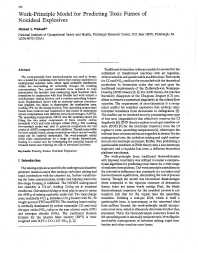Mining Publication: Work-Principle Model for Predicting Toxic Fumes of Nonideal Explosives
Original creation date: August 2004
The work-principle from thermodynamics was used to formulate a model for predicting toxic fumes from mining explosives in underground chamber tests, where rapid turbulent combustion within the surrounding air noticeably changes the resulting concentrations. Two model constants were required to help characterize the reaction zone undergoing rapid chemical transformations in conjunction with heat transfer and work output: a stoichiometry mixing fraction and a reaction-quenching temperature. Rudimentary theory with an unsteady uniform concentration gradient was taken to characterize the combustion zone, yielding 75% for the mixing fraction. Four quenching temperature trends were resolved and compared to test results of ammonium nitrate compositions with different fuel-oil percentages (ANFO). The quenching temperature 2,345 K was the optimum choice for fitting the two major components of fume toxicity: carbon monoxide and total nitrogen oxides. The resulting two-constant model was used to generate comparisons for test results of ANFO compositions with additives. Although respectable fits were usually found, charge formulations that reacted weakly could not be resolved numerically. The work-principle model yields toxic concentrations for a range of charge formulations, making it a useful tool for investigating the potential hazard of released fumes and reducing the risk of unwanted incidents.
Authors: MS Wieland
Peer Reviewed Journal Article - August 2004
NIOSHTIC2 Number: 20025499
Propellants Explos Pyrotech 2004 Aug; 29(4):236-243
See Also
- Emergency Escape and Refuge Alternatives
- Factors Affecting ANFO Fumes Production
- How to Operate a Refuge Chamber: A Quick Start Guide
- Recommendations for Refuge Chamber Operations Training
- Refuge Alternatives in Underground Coal Mines
- Refuge Chamber Expectations Training - 1.0
- Technology News 537 - NIOSH Develops New Mine Refuge Chamber Training
- Thermal Stability of ANFO Made with Recycled Oil
- Underground Mine Refuge Chamber Expectations Training: Program Development and Evaluation
- When Do You Take Refuge? Decisionmaking During Mine Emergency Escape
- Content source: National Institute for Occupational Safety and Health, Mining Program


 ShareCompartir
ShareCompartir
